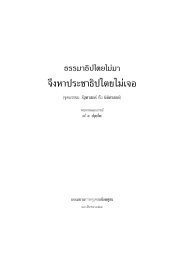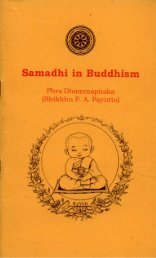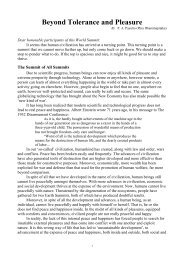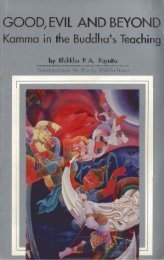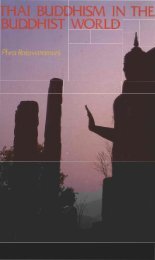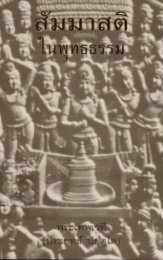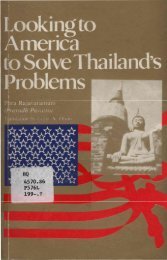- Page 1 and 2: The Iconography of Nepalese Buddhis
- Page 3: e of Nepalese Buddhism by Min Bahad
- Page 6 and 7: niques: Lost Wax Process, Chisellin
- Page 8 and 9: and appreciated about the importanc
- Page 10 and 11: III. Sambhogakaya Representation 3.
- Page 12 and 13: 7.7 Lokanath Lokeshvara ...........
- Page 14 and 15: 14.7 Takkiraja or Vajrayaksha .....
- Page 16 and 17: Buddha Shakyamuni (Mahabodhi Temple
- Page 18 and 19: Sarvanivarana Bodhisattva .........
- Page 20 and 21: he conography of epalese uddhism
- Page 22 and 23: At various places such as Dhanyakat
- Page 26 and 27: “e formation of an enlightened at
- Page 28 and 29: the integral part of the path for a
- Page 30 and 31: not realize Dharmakaya in their lif
- Page 32 and 33: 3. He is endowed with mastery of mi
- Page 34 and 35: Another form of Nirmanakaya is a Tu
- Page 36 and 37: ese five Buddhas are not the subdiv
- Page 38 and 39: with these practices since these de
- Page 40 and 41: ese Dakinis generally travel throug
- Page 42 and 43: images and were sent to Tibet, Chin
- Page 44 and 45: II. Dharmakaya Representation 2.1.
- Page 46 and 47: III. Sambhogakaya Representation 3.
- Page 48 and 49: uddha airocana › (bronze) ‹ ajr
- Page 50 and 51: joined displaying Bodhyanga mudra.
- Page 52 and 53: mirror every visible object reflect
- Page 54 and 55: jewel in his left hand kept on his
- Page 56 and 57: Amitabha in Sanskrit means immeasur
- Page 58 and 59: ody is bright, like lapislazuli. He
- Page 60 and 61: 3.9 Amitayus or Buddha Aparimita Bu
- Page 62 and 63: uddha hakyamuni (ahabodhi emple, at
- Page 64 and 65: mood to honor Buddha Dipamkara. He
- Page 66 and 67: uddha ishvabhu › uddha ‹ ipashv
- Page 68 and 69: ikhi uddha › uddha ‹ rakuchchan
- Page 70 and 71: sattva, who was to become Shakyamun
- Page 72 and 73: During his career Buddha Kanakamuni
- Page 74 and 75:
Shakyamuni Buddha was born in Kapil
- Page 76 and 77:
V. Gurus 5.1 Guru Nagarjuna Guru Na
- Page 78 and 79:
78 uru adma ‹ ambhava (bronze) In
- Page 80 and 81:
she also suggested him to consult G
- Page 82 and 83:
He was invited to Tibet to eliminat
- Page 84 and 85:
uru songhkapa › uru ‹ ilarepa (
- Page 86 and 87:
5.8 Guru Sakya Pandit Guru Sakya Pa
- Page 88 and 89:
amantabhadra odhisattva
- Page 90 and 91:
sitigarbha odhisattva
- Page 92 and 93:
6.3 Akashgarbha or Khagarbha Bodhis
- Page 94 and 95:
kashagarbha or hagharba odhisattva
- Page 96 and 97:
and Odiyana Acarya continued to pay
- Page 98 and 99:
offering ceremonies in honour of hi
- Page 100 and 101:
Vajrapani is often depicted with Av
- Page 102 and 103:
ya aitreya (silver)
- Page 104 and 105:
VII. Forms Of Avalokitesvara 7.1 Pa
- Page 106 and 107:
7.2 Amoghpash Lokeshvara Amoghpash
- Page 108 and 109:
hand holding a rosary signifies tha
- Page 110 and 111:
arihariharihari ahan okeshvara ›
- Page 112 and 113:
efore him throwing away his Sudrash
- Page 114 and 115:
akta ryavalokiteshvara (ungadeo,
- Page 116 and 117:
was the emanation of Arya Avalokite
- Page 118 and 119:
7.8 One Thousand-armed Lokeshvara o
- Page 120 and 121:
like earrings, and so on. He has el
- Page 122 and 123:
VIII. Manjushree & His Forms 8.1 Ar
- Page 124 and 125:
8.2 Manjughosha is form of Manjushr
- Page 126 and 127:
Manjughosa instantly appeared in th
- Page 128 and 129:
Different forms of Manjushree image
- Page 130 and 131:
aeons ago. During Shakyamuni’s ti
- Page 132 and 133:
hite ara › (bronze) ‹ reen ara
- Page 134 and 135:
her Mantra merely a hundred thousan
- Page 136 and 137:
existence and destruction. Her Vara
- Page 138 and 139:
X. Prajnas Of Five Buddhas (Panca B
- Page 140 and 141:
wheel. She is said to be Prajna of
- Page 142 and 143:
family and is the nature of hatred.
- Page 144 and 145:
ara
- Page 146 and 147:
XI. Deities of Anuttara Yoga Tantra
- Page 148 and 149:
ornaments, such as the earrings, th
- Page 150 and 151:
akrasamvara › ‹ ayagriva (bronz
- Page 152 and 153:
deity or Yidam deity. Nepalese Budd
- Page 154 and 155:
In his six-armed form, he has three
- Page 156 and 157:
She holds a Kartri in her right han
- Page 158 and 159:
XIII. Five Protectress Deities: Pan
- Page 160 and 161:
against various sorts of unseen dan
- Page 162 and 163:
the people of Vaishali the Buddha d
- Page 164 and 165:
this incident with tears in his eye
- Page 166 and 167:
ahamantranusarini
- Page 168 and 169:
that he is the emanation of Bodhisa
- Page 170 and 171:
cala › ‹ ighnantaka
- Page 172 and 173:
etinue was quite effective. Odiyana
- Page 174 and 175:
trident, a sword, a jewel and a lot
- Page 176 and 177:
admanantaka › akkiraja ‹ or ajr
- Page 178 and 179:
snisa › ‹ iladanda
- Page 180 and 181:
hritarastra
- Page 182 and 183:
irpaksha › ‹ irudhak
- Page 184 and 185:
His body is red in colour. He shows
- Page 186 and 187:
XVI. Eight Dikpalas (Eight Deities
- Page 188 and 189:
16.2 Yama Yama or Yamaraja is anoth
- Page 190 and 191:
16.3 Kuvera Kuvera is one of the mo
- Page 192 and 193:
gni eva › ‹ aruna
- Page 194 and 195:
certainly attain Buddhahood in futu
- Page 196 and 197:
sana eva
- Page 198 and 199:
17.1 Mahakala XVII. Guardian Deitie
- Page 200 and 201:
e characteristic feature of the Pro
- Page 202 and 203:
Bibliography Banerjee, Biswonath ri
- Page 204 and 205:
Menon, I. & Farrow, G.W. e evajrata
- Page 206 and 207:
laka — Abode of Kuvera, the deity
- Page 208 and 209:
amara — Chowris or the fly whisk
- Page 210 and 211:
atamattrochcha — Mountain Peak be
- Page 212 and 213:
hanikeshara vitaraga — a shrine n
- Page 214:
tpala — a blue lotus ttaratantra





